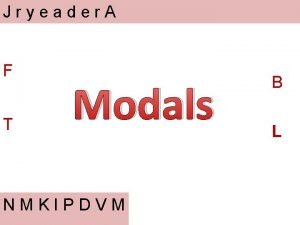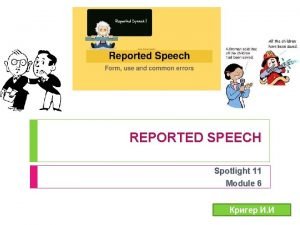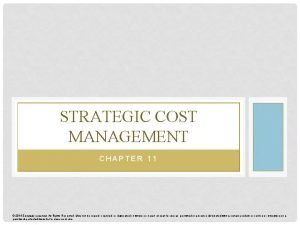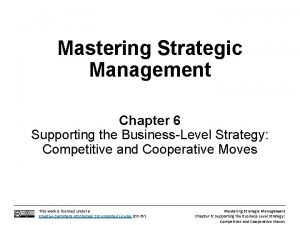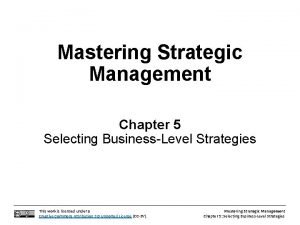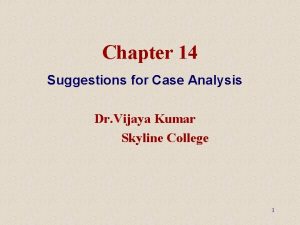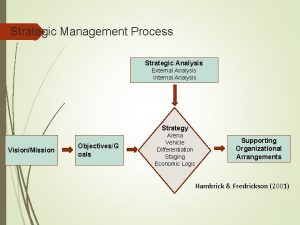CHAPTER 15 Suggestions for Case Analysis STRATEGIC MANAGEMENT























![Index of Sustainable Growth g*= [ p (1 – D) (1 + L)] / Index of Sustainable Growth g*= [ p (1 – D) (1 + L)] /](https://slidetodoc.com/presentation_image_h/f9e7f825dca2a34c19ecd26d1fd4e936/image-24.jpg)



- Slides: 27

CHAPTER 15 Suggestions for Case Analysis STRATEGIC MANAGEMENT & BUSINESS POLICY 10 TH EDITION THOMAS L. WHEELEN J. DAVID HUNGER 1

Suggestions for Case Analysis Checklist for Red Flags – –Cash flow from operations should exceed net income –Accounts receivable should not grow faster than sales 2

Suggestions for Case Analysis Checklist for Red Flags – –Gross margins should not fluctuate over time –Information re: top management and Board should be examined carefully –Footnotes are important 3

Suggestions for Case Analysis Research – –Reach beyond the information in the case –Focus on environmental setting –Check decision date of case 4

Suggestions for Case Analysis Research – –Use information services • COMPUSTATE • Compact Disclosure • CD/International • www. hoovers. com • www. sec. gov 5

Suggestions for Case Analysis Financial Ratios are Important – –Ration Analysis • Liquidity ratios • Profitability ratios • Activity ratios • Leverage ratios 6

Suggestions for Case Analysis – –Research • Annual reports • 10 K forms • Income statement • Balance sheets 7

Suggestions for Case Analysis – –Research • Cash flow statements • Economic conditions • Industry information 8

Suggestions for Case Analysis Financial Analysis – – 5 Basic Steps • Historical income statements/balance sheets • Compare historical statements over time • Calculate changes individual items-cumulative • Change as percentage and absolute amount • Adjust for inflation if significant factor 9

Financial Ratio Analysis -- Liquidity Formula 1. Liquidity Ratios Current ratio Quick (acid test) ratio Inventory to net working capital Cash ratio How Expressed Meaning Current assets ————— Current liabilities Decimal A short-term indicator of the company’s ability to pay its short-term liabilities from short-term assets; how much of current assets are available to cover each dollar of current liabilities. Current assets – Inventory —————— Current liabilities Decimal Measures the company’s ability to pay off its short-term obligations from current assets, excluding inventories. Inventory ———————— Current assets – Current liabilities Decimal A measure of inventory balance; measures the extent to which the cushion of excess current assets over current liabilities may be threatened by unfavorable changes in inventory. Cash + Cash equivalents —————— Current liabilities Decimal Measures the extent to which the company’s capital is in cash or cash equivalents; shows how much of the current obligations can be paid from cash or near-cash assets. 10

Financial Ratio Analysis -- Profitability Formula 2. Profitability Ratios Net profit margin Gross profit margin Return on investment (ROI) Return on equity (ROE) Earnings per share (EPS) How Expressed Meaning Net profit after taxes ————— Net sales Percentage Shows how much after-tax profits are generated by each dollar of sales. Sales – Cost of goods sold ——————— Net sales Percentage Net profit after taxes ————— Total assets Indicates the total margin available to cover other expenses beyond cost of goods sold, and still yield a profit. Percentage Measures the rate of return on the total assets utilized in the company; a measure of management’s efficiency, it shows the return on all the assets under its control regardless of source of financing. Net profit after taxes ————— Shareholders’ equity Percentage Net profit after taxes – preferred stock dividends —————— Average number of common shares Measures the rate of return on the book value of shareholders’ total investment in the company. Dollars per share Shows the after-tax earnings generated for each share of common stock. 11

Financial Ratio Analysis -- Activity Formula 3. Activity Ratios Inventory turnover Net sales ——————— Inventory Days of inventory Inventory —————— Cost of goods sold ÷ 365 Net working capital turnover Asset turnover Fixed asset turnover Average collection period Accounts receivable turnover Accounts payable period Days of cash Net sales ————— Net working capital How Expressed Decimal Days Decimal Sales ————— Total assets Decimal Sales ——————— Fixed assets Decimal Accounts receivable ————— Sales for year ÷ 365 Days Annual credit sales ————— Accounts receivable Decimal Accounts payable —————— Purchases for year ÷ 365 Cash —————— Net sales for year ÷ 365 Days Meaning Measures the number of times that average inventory of finished goods was turned over or sold during a period of time, usually a year. Measures the number of one day’s worth of inventory that a company has on hand at any given time. Measures how effectively the net working capital is used to generate sales. Measures the utilization of all the company’s assets; measures how many sales are generated by each dollar of assets. Measures the utilization of the company’s fixed assets (i. e. , plant and equipment); measures how many sales are generated by each dollar of fixed assets. Indicates the average length of time in days that a company must wait to collect a sale after making it; may be compared to the credit terms offered by the company to its customers. Indicates the number of times that accounts receivable are cycled during the period (usually a year). Indicates the average length of time in days that the company takes to pay its credit purchases. Indicates the number of days of cash on hand, at present sales levels. 12

Financial Ratio Analysis -- Leverage Formula How Expressed Meaning 4. Leverage Ratios Total debt ——————— Total assets Percentage Measures the extent to which borrowed funds have been used to finance the company’s assets. Debt to equity ratio Total debt ————— Shareholders’ equity Percentage Measures the funds provided by creditors versus the funds provided by owners. Long-term debt to capital structure Long-term debt ————— Shareholders’ equity Percentage Measures the long-term component of capital structure. Profit before taxes + Interest charges ———————— Interest charges Decimal Indicates the ability of the company to meet its annual interest costs. Profit before taxes + Interest charges + Lease charges ———————— Interest charges + Lease obligations Decimal A measure of the company’s ability to meet all of its fixed-charge obligations. Percentage Measures the short-term financing portion versus that provided by owners. Debt to asset ratio Times interest earned Coverage of fixed charges Current liabilities to equity Current liabilities ————— Shareholders’ equity 13

Financial Ratio Analysis -- Other Financial Ratio Analysis — Other Formula 5. Other Ratios Price/earning ratio Dividend payout ratio Dividend yield on common stock Market price per share ————— Earnings per share How Expressed Meaning Decimal Shows the current market’s evaluation of a stock, based on its earnings; shows how much the investor is willing to pay for each dollar of earnings. Annual dividends per share —————— Annual earnings per share Percentage Indicates the percentage of profit that is paid out as dividends. Annual dividends per share ———————— Current market price per share Percentage Indicates the dividend rate of return to common shareholders at the current market price. Note: In using ratios for analysis, calculate ratios for the corporation and compare them to the average and quartile ratios for the particular industry. Refer to Standard and Poor’s and Robert Morris Associates for average industry data. Special thanks to Dr. Moustafa H. Abdelsamad, Dean, Business School, Texas A&M University–Corpus Christi, Texas, for his definitions of these ratios. 14

Suggestions for Case Analysis Resources – Library – – Moody’s Manuals on Investment –Standard & Poor’s Register –Value Line’s Investment Survey –Findex: The Directory of Market Research. . 15

Suggestions for Case Analysis Resources – Economic Information – – Business Cycle Development –U. S. Census Bureau –Current Business Reports –Economic Indicators 16

Suggestions for Case Analysis Resources – Economic Information – – Long-Term Economic Growth –Monthly Labor Review –U. s. Industrial Outlook –Overseas Business Reports 17

Suggestions for Case Analysis Resources – Industry – – Business Week –Fortune –Industry Survey –Industry Week –Forbes –Inc 18

Suggestions for Case Analysis Resources – Directories – – Business Periodical Index –Directory of National Trade Associations –Encyclopedia of Associations 19

Suggestions for Case Analysis Resources – Directories – – Funk & Scott’s Index of Corporations and Industries –Thomas’ Register of American Manufacturers –Wall Street Journal Index 20

Suggestions for Case Analysis Resources – Ratio Analysis – – Almanac of Business & Industrial Financial Ratios –Annual Statement Studies –Dun’s Review –Industry Norms and Key Business Ratios 21

Suggestions for Case Analysis Common Size Statements -– Income statements and balance sheets in which the dollar figures have been converted into percentages 22

Altman’s Bankruptcy Formula Z = 1. 2 x 1 + 1. 4 x 2 + 3. 3 x 3 + 0. 6 x 4 + 1. 0 x 5 where x 1 = Working capital divided by total assets. x 2 = Retained earnings divided by total assets. x 3 = Earnings before interest and taxes divided by total assets. x 4 = Market value of equity divided by total liabilities. x 5 = Sales divided by total assets. Z = Overall index of corporate fiscal health. 23
![Index of Sustainable Growth g p 1 D 1 L Index of Sustainable Growth g*= [ p (1 – D) (1 + L)] /](https://slidetodoc.com/presentation_image_h/f9e7f825dca2a34c19ecd26d1fd4e936/image-24.jpg)
Index of Sustainable Growth g*= [ p (1 – D) (1 + L)] / [T – P (1 – D) (1+L)] where P = Net profit before taxes/net sales x 100 D = Target dividends/profit after tax L = Total liabilities/net worth T = Total assets/net sales x 100 24

Strategic Audit Worksheet Part I 25

Strategic Audit Worksheet Part II 26

Strategic Audit Convert the following two years of income statements from the Maytag Corporation into common-size statements. The dollar figures are in thousands. What does converting to a common size reveal? 1992 % 1991 % Net sales $3, 041, 223 $2, 970, 626 Cost of sales 2, 339, 406 2, 254, 221 ————— Gross profits 701, 817 716, 405 Selling, general, and admin. 528, 250 524, 898 expenses Reorganization expenses 95, 000 — ————— Operating income 78, 567 191, 507 Interest expense (75, 004) (75, 159) Other—net 3, 983 7, 069 ————— Income before taxes and accounting changes 7, 546 123, 417 Income taxes (15, 900) (44, 400) Income before accounting changes (8, 354) 79, 017 Effects of accounting changes for post-retirement benefits (307, 000) — ————— Net income (loss) $(315, 354) $79, 017 ————— ————— 27
 Cultural aspects of strategy choice
Cultural aspects of strategy choice Industrial organization model of above average returns
Industrial organization model of above average returns Best worst and average case
Best worst and average case Competitive profile matrix of mcdonalds
Competitive profile matrix of mcdonalds Zara strategic management
Zara strategic management Strategic analysis tools and techniques
Strategic analysis tools and techniques Ba 491
Ba 491 Perfect modals ejemplos
Perfect modals ejemplos Expressions to make suggestions
Expressions to make suggestions Making suggestions conversation
Making suggestions conversation Giving advice and making suggestions
Giving advice and making suggestions Making plans and suggestions
Making plans and suggestions Reported order
Reported order Past modals for judgments and suggestions
Past modals for judgments and suggestions Making suggestions and recommendations
Making suggestions and recommendations Collegial
Collegial Perfect modals examples
Perfect modals examples Comments and suggestions for teachers observation
Comments and suggestions for teachers observation Reported questions
Reported questions Suggestions and queries
Suggestions and queries Making suggestions
Making suggestions Request sentence
Request sentence Life skills chapter 2
Life skills chapter 2 Strategic fit vs strategic intent
Strategic fit vs strategic intent Strategic complements and substitutes
Strategic complements and substitutes Chapter 11 strategic cost management
Chapter 11 strategic cost management Mastering strategic management
Mastering strategic management Strategic management chapter 5
Strategic management chapter 5













